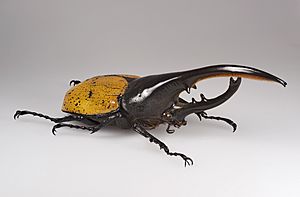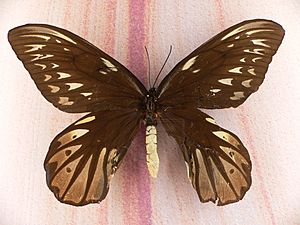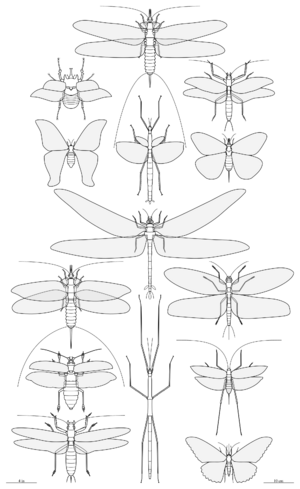List of largest insects facts for kids
Insects are amazing creatures! They are a type of arthropod, which means they have an exoskeleton and jointed legs. Insects are the most common group of multicellular organisms on Earth. Scientists have found over a million different kinds of insects so far.
When we talk about the heaviest insect, there are a few contenders. The larval stage (baby stage) of the goliath beetle is often called the heaviest. These larvae can weigh at least 115 grams (about 4 ounces) and be 11.5 centimeters (4.5 inches) long. For adult insects, the heaviest confirmed weight is 71 grams (2.5 ounces) for a giant weta. However, some elephant beetles or goliath beetles might be heavier. They often weigh more than 50 grams (1.8 ounces) and are over 10 centimeters (4 inches) long.
The longest insects are the incredible stick insects, which we'll learn more about below.
Long ago, there were giant dragonfly-like insects called Meganisoptera. These included Meganeura monyi from the Carboniferous period and Meganeuropsis permiana from the Permian period. They are the largest insect species ever known! These ancient creatures had huge wingspans of about 71 centimeters (28 inches). Imagine a dragonfly as big as a hawk!
Contents
- Giant Dragonflies and Damselflies (Odonata)
- Big Grasshoppers, Crickets, and Relatives (Orthoptera)
- Long Stick Insects (Phasmatodea)
- Big Cockroaches and Termites (Blattodea)
- Giant Praying Mantises (Mantodea)
- Huge True Bugs (Hemiptera)
- Big Dobsonflies and Relatives (Megaloptera)
- Large Net-winged Insects (Neuroptera)
- Big Stoneflies (Plecoptera)
- Giant Beetles (Coleoptera)
- Ants, Bees, and Wasps (Hymenoptera)
- Huge Butterflies and Moths (Lepidoptera)
- Big True Flies (Diptera)
- Caddisflies (Trichoptera)
- See also
Giant Dragonflies and Damselflies (Odonata)
Dragonflies and damselflies belong to an order called Odonata. The living species with the biggest wingspan is Megaloprepus caerulatus, which can reach 19 centimeters (7.5 inches) across its wings. Another dragonfly, Petalura ingentissima, has a wingspan of 16.5 centimeters (6.5 inches). Tetracanthagyna plagiata is a close second at 16.3 centimeters (6.4 inches).
The damselfly Chlorogomphus papilio has the largest wing surface area among living odonates. This means its wings are very wide.
For body length, the longest living odonate is Mecistogaster lucretia. Its body can be 15.5 centimeters (6.1 inches) long.
The heaviest living odonate is likely Petalura ingentissima or Tetracanthagyna plagiata. Other large species like Anax strenuus and Anotogaster sieboldii are also very heavy.
Big Grasshoppers, Crickets, and Relatives (Orthoptera)
Some of the largest insects in this group are Arachnacris katydids and Tropidacris grasshoppers. They can grow up to 12–15 centimeters (4.7–5.9 inches) long. Their wingspan can reach 23–27.5 centimeters (9.1–10.8 inches).
The heaviest insect in this group is the Little Barrier Island giant weta from New Zealand. One of these amazing insects weighed 71 grams (2.5 ounces) and was almost 10 centimeters (3.9 inches) long. This makes it one of the heaviest insects ever known! These heavy insects can be over 9 centimeters (3.5 inches) long.
Giant Extinct Titanopterans (Titanoptera)
Long ago, during the Triassic period, there were insects called Titanoptera. They were related to modern grasshoppers and crickets but were much bigger. Gigatitan vulgaris had a wingspan of up to 40 centimeters (16 inches). Another huge one was Clatrotitan andersoni, with a forewing 13.8 centimeters (5.4 inches) long.
Long Stick Insects (Phasmatodea)
The longest known stick insects are also the longest insects in the world! They are usually very light because of their thin bodies. Female stick insects are often much larger than males of the same species.
The current record holder is an undescribed species of Phryganistria found in China in 2014. A female from the wild, kept at the Insect Museum of West China, was 62.4 centimeters (24.6 inches) long with her legs stretched out. Her body alone was 36.1 centimeters (14.2 inches). One of her babies, raised in captivity, grew even longer, reaching 64 centimeters (25 inches) in total length!
Before this discovery, Phobaeticus chani was thought to be the longest. A specimen in the Natural History Museum in London is 56.7 centimeters (22.3 inches) long with legs. Its body is 35.7 centimeters (14.1 inches).
Other very long stick insects include the Australian Ctenomorpha gargantua, which can be 56.5 centimeters (22.2 inches) long. Phobaeticus kirbyi can reach 54.6 centimeters (21.5 inches) in total length. Phobaeticus serratipes from Malaysia and Singapore can be up to 55.5 centimeters (21.9 inches) long.
The spiny stick insect (Heteropteryx dilatata) from Southeast Asia isn't as long as its cousins, but it's much heavier. Its body can be up to 16 centimeters (6.3 inches) long. The largest Heteropteryx weighed about 65 grams (2.3 ounces) and was 3.5 centimeters (1.4 inches) wide.
Big Cockroaches and Termites (Blattodea)
The largest cockroach in length and wingspan is the South American Megaloblatta longipennis. It can be up to 9.7 centimeters (3.8 inches) long and have a wingspan of 18–20 centimeters (7.1–7.9 inches). Other big cockroaches include Blaberus giganteus, which can be 9 or 10 centimeters (3.5 or 3.9 inches) long. Princisia vanwaerebeki from Madagascar grows to 5.6 to 10 centimeters (2.2 to 3.9 inches).
The heaviest cockroach is the Australian giant burrowing cockroach (Macropanesthia rhinoceros). It can be 8.4 centimeters (3.3 inches) long and weigh 33.5 grams (1.2 ounces).
Termites
The largest of the termites is the African species Macrotermes bellicosus. The queen of this species can grow to 10.6 centimeters (4.2 inches) long and 5.5 centimeters (2.2 inches) wide. Other adult termites in the colony are much smaller, about a third of the queen's size.
Giant Praying Mantises (Mantodea)
The giant stick mantises Toxodera maxima and Ischnomantis gigas can be over 17 centimeters (6.7 inches) long. They are thinner than other large mantises. Other species like Heterochaeta can also reach lengths over 16 centimeters (6.3 inches).
Some mantises, like Rhombodera fratricida, can be nearly 13 centimeters (5.1 inches) long. These mantises are very strong. Some large species have even been seen catching and eating frogs, lizards, mice, small birds, small fish, and even small snakes!
Huge True Bugs (Hemiptera)
This group includes many different insects. The heaviest species are the giant water bugs Lethocerus grandis and Lethocerus maximus. They can be longer than 12 centimeters (4.7 inches). They are not as heavy as some huge beetles, though.
The largest wingspan in this group belongs to the biggest cicada: Megapomponia imperatoria. It has a body length of about 7 centimeters (2.8 inches) and a wingspan of 18–20 centimeters (7.1–7.9 inches).
The longest total length in this group belongs to Gigantometra gigas, the largest water strider. Its legs can span more than 25 centimeters (9.8 inches)!
Big Dobsonflies and Relatives (Megaloptera)
This group includes dobsonflies and alderflies. The largest is the dobsonfly Acanthacorydalis fruhstorferi. It can have a wingspan of up to 21.6 centimeters (8.5 inches). This makes it the largest aquatic insect in the world by wingspan. This species lives in China and Vietnam. Its body can be up to 10.5 centimeters (4.1 inches) long.
Large Net-winged Insects (Neuroptera)
These flying insects are largest in Palparellus voeltzkowi, which can have a wingspan over 16 centimeters (6.3 inches). The biggest lacewing is the Australian "blue eyes lacewing" (Nymphes myrmeleonides). It can be up to 4 centimeters (1.6 inches) long and have an 11-centimeter (4.3-inch) wingspan.
Some ancient forms of this order were huge during the Jurassic period. Makarkinia adamsi, found in rocks from the Early Cretaceous period, had wings nearly 14–16 centimeters (5.5–6.3 inches) long.
Big Stoneflies (Plecoptera)
The largest species of stonefly is Pteronarcys californica from western North America. Fishermen like to use this species as bait. It can be 5 centimeters (2.0 inches) long and have a wingspan of over 8 centimeters (3.1 inches).
Giant Beetles (Coleoptera)

Beetles are the most diverse group of organisms on Earth. There are about 400,000 different species! The heaviest beetles belong to groups like Goliathus, Megasoma, Chalcosoma, Titanus, Macrodontia, and Xixuthrus.
The longest beetle is the Hercules beetle, Dynastes hercules. It can be at least 18.1 centimeters (7.1 inches) long, including its very long horn on its back.
Another very long beetle is a type of longhorn beetle, Batocera wallacei, from New Guinea. It can reach a total length of 26.6 centimeters (10.5 inches). About 19 centimeters (7.5 inches) of that length is just its long antennae!
Ants, Bees, and Wasps (Hymenoptera)

The largest ants, and the heaviest in their family, are the queens of Dorylus helvolus. They can reach a length of 5 centimeters (2.0 inches). The ant with the largest average size for its whole colony is Dinoponera gigantea, averaging up to 3.3 centimeters (1.3 inches). Another large ant from Australia, Myrmecia brevinoda, has workers that are about 3.7 centimeters (1.5 inches) long. Its queens can be more than 4 centimeters (1.6 inches) long.
The largest bee is Megachile pluto. Female bees can be 3.8 centimeters (1.5 inches) long, with a 6.3-centimeter (2.5-inch) wingspan.
The largest wingspan for any wasp probably belongs to the tarantula hawk species Pepsis heros. It can measure up to 12.2 centimeters (4.8 inches) across its wings. Many other Pepsis species are also very large.
The heaviest wasp is likely the giant scoliid wasp Megascolia procer or the queens of the Asian giant hornet (Vespa mandarinia). The scoliid wasp can be over 6.5 centimeters (2.6 inches) long with a 9.9-centimeter (3.9-inch) wingspan. The Asian giant hornet queen can be over 6 centimeters (2.4 inches) long with a 9.3-centimeter (3.7-inch) wingspan.
Huge Butterflies and Moths (Lepidoptera)

The largest butterfly or moth species is often said to be either the Queen Alexandra's birdwing (Ornithoptera alexandrae) from Papua New Guinea, or the Atlas moth (Attacus atlas) from Southeast Asia. Both can reach 8 centimeters (3.1 inches) long, have a wingspan of 28 centimeters (11 inches), and weigh 12 grams (0.42 ounces). One Atlas moth was said to have a 30-centimeter (12-inch) wingspan, but this wasn't officially confirmed.
However, the white witch moth from Central and South America, Thysania agrippina, has the widest recorded wingspan of any living insect. It can be up to 30 centimeters (12 inches) across its wings. The largest confirmed Thysania had a wingspan of 30.8 centimeters (12.1 inches). Some reports even say they can reach 36 centimeters (14 inches)!
The largest moth by body mass (weight) is the giant wood moth Endoxyla cinereus. Even though its wingspan is smaller than others, it weighs about 30 grams (1.1 ounces), making it heavier than all the others.
The Hercules moth (Coscinocera hercules) has the largest documented wing surface area of any living insect, at 300 square centimeters (47 square inches). It has a confirmed maximum wingspan of 28 centimeters (11 inches). Some unconfirmed specimens have spanned up to 35.5 centimeters (14.0 inches).
Big True Flies (Diptera)
The fly with the largest wingspan in this huge group is Gauromydas heros. It can reach a wingspan of 10 centimeters (3.9 inches) and a length of 6 centimeters (2.4 inches). It's also a contender for the longest body length among true flies.
The heaviest flies are definitely the timber flies from the group Pantophthalmus.
The largest total length for any fly belongs to the biggest crane fly: Holorusia brobdignagia. If its legs are stretched out, it can be 23 centimeters (9.1 inches) long, making it the longest true fly.
Caddisflies (Trichoptera)
The largest of the small, moth-like caddisflies is Eubasilissa maclachlani. This species can have a wingspan of up to 7 centimeters (2.8 inches).
See also
- Largest prehistoric animals










